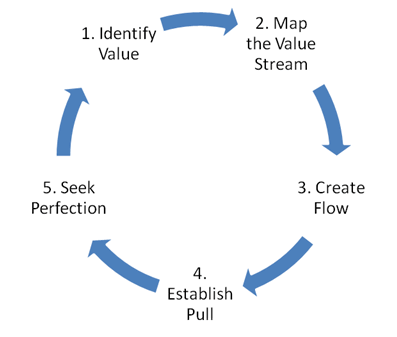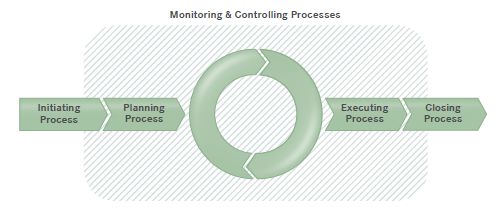Lean Project Management
(→How to manage projects in a Lean way) |
(→How to manage projects in a Lean way) |
||
| Line 44: | Line 44: | ||
= How to manage projects in a Lean way = | = How to manage projects in a Lean way = | ||
| − | |||
| − | |||
[[File:Project processes.png|200px|frame|text-bottom|PMI 5-phase delivery model (PMBOK Guide)]] | [[File:Project processes.png|200px|frame|text-bottom|PMI 5-phase delivery model (PMBOK Guide)]] | ||
| + | |||
| + | Based on the principles of LPM, it is explained how to manage a project in a Lean way. Some specific Lean tools and techniques that can be applied to projects are proposed through the project process.Project Management can be highly complex. So the analysis is done in a sequence of steps which need to be completed to accomplish projects. In the "traditional approach" (1) processes are grouped in five development phases: | ||
Revision as of 09:55, 20 November 2014
Many companies fully or partially live in a project world, although most of them do not act as project-driven companies. Competition in our industry increasingly makes more important the desire of optimizing what leads to provide our customers better service or product, within the time and cost agreed, and to the extent expected by them. Lean Project Management seeks precisely that goal.
The purpose of this article is to explain how the Lean principles can be applied to make project management more efficient. Lean Project Management guide organizations toward a model of high productivity management at all stages of a project. The procedure used to analyze this issue throughout the article is the following. First, the causes of projects failure are identified, clarifying the room of improvement. Second, the objectives and principles of Lean Project Management are defined. By recommending tools and techniques it is shown how to manage projects in a Lean way. Finally, the benefits of Lean Thinking in Project Management are concluded. A collection of articles and papers will support these ideas.
Contents |
Background
History
Kiichiro Toyoda, Taiichi Ohno, and others at Toyota are the developers of the Toyota Production System (TPS) in the 1930s. This system shifted the focus of the manufacturing systems from individual machines and their utilization, to the flow of the product through the total process. Lean manufacturing is a management philosophy derived mostly from the TPS and Lean principles are derived from the Japanese manufacturing industry. The philosophy has identified as “lean” only in the 1990s and the term was used first by John Krafcit who described the thought process of lean in the book “The Machine That Changed the World”, co-authored by James P. Womack, Daniel T. Jones, and Daniel Roos. Lean implementation is focused on getting the right things to the right place at the right time in the right quality to achieve perfect work flow, while minimizing waste and being flexible.
Current status
Toyota has been the leading lean exemplar in the world and stands as the strongest proof of the power of lean enterprise. This continued success has over the past two decades created an enormous demand for greater knowledge about this management philosophy. Nowadays, there are hundreds of books and articles about lean thinking and there is an increasingly trend to spread the lean principles beyond manufacturing to other sectors (construction, services, logistics, healthcare…). Also lean thinking is beginning to take root among project managers and LPM is the application of Lean manufacturing to Project Management to improve quality and increase efficiency in projects. Firms operating in fast-changing and highly competitive markets in which the quick adjustment to dynamic environments is essential, project managers increasingly work to improve quality, flexibility and customer response time using principles of Lean thinking (2).
According to several studies from the Project Management Institute (PMI) and others that look into the success/failure rates of projects, only 40% of projects met schedule, budget and quality goals. The rest were aborted or completed unsuccessfully. This means that more than one out to three projects fail. Also, there seems to be evident that the longer the project and the team size, the harder is the failure. The studies reveal that the main causes for projects failing are breakdown in communications, a lack of planning and poor quality control. As a consequence, the root cause for project failure can usually be tracked back to a lack of proper Project Management. So, there is a room of improvement in project processes and this is the goal of LPM philosophy.
Principles of LPM
Lean Project Management uses the five main principles from Lean manufacturing into a Project Management context to focus on delivering more value with less waste and reduced time in a project context. They represent essential conditions to achieve both market acceptance and operational excellence (3).
- Principle 1: Specify the value of each project desired by the customer
- Principle 2: Identify the value stream for each project
- Principle 3: Make the project flow continuously without interruptions
- Principle 4: Introduce the customer pull from the project team between all continuous flow steps
- Principle 5: Continuously pursue perfection
LPM takes into account three important statements:
- It is not necessary to finish each task on time to finish a project on time.
- Starting a project sooner does not mean it will finish sooner.
- Adding buffers (protection spaces) reduces project time and cost.
A principle that underlies LPM is that any project worth doing is worth doing fast (2). As a result, Lean Project Management helps projects run smoother and it is the quickest way to shorten project duration, reduce quality defects and boost productivity levels.
How to manage projects in a Lean way
Based on the principles of LPM, it is explained how to manage a project in a Lean way. Some specific Lean tools and techniques that can be applied to projects are proposed through the project process.Project Management can be highly complex. So the analysis is done in a sequence of steps which need to be completed to accomplish projects. In the "traditional approach" (1) processes are grouped in five development phases:
1. Initiating Process
2. Planning Process
3. Executing Process
4. Closing Process
5. Monitoring and Controlling Processes
The groups overlap, and the last group applies to all of the processes. It is relevant to consider that projects and Project Management processes vary from industry to industry; however, these five steps of the delivery model are more traditional elements and can be applied to all kinds of projects. Even if the company is not directly project related, there is always an overarching goal to benefit the organization by means of projects; typically offering a product, changing a process or solving a problem.
Initiating Process
Following Principle 1 and the philosophy of only keeping activities and projects which add value desired by the costume, the first decision before starting any project is prioritize the present portfolio. There is no sense to squander time and resources doing work that the project’s customer is not willing to pay for. Evaluation, selection and prioritization of projects is a required practice to implement Lean thinking, the reason is simple: it is less costly to stop a project before it has been started. Many methods exist for the selection of projects,
Planning Process
Executing Process
Monitoring and Controlling Processes
Closing Process
Benefits of LPM
Clarification of the benefits of LPM in current projects.
Typically in the last decade, delivery times have been cut by 50%, productivity increased by 30%, and quality improved by a factor of 10.

